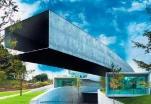Light and Architecture

Starting with this issue, we begin to publish chapters from the book “Sustainable Architecture In Japan: The Continuing Challenge 1900-2010 & Beyond”, Nobuyuki Yoshida, Shinkenchikusha Co. Ltd., 2010, published to coincide with the company’s hundred tenth anniversary, and describing the innovative design solutions that promote preservation of the environment.
The materiality and space of architecture only emerges with light. Depending on its qualities, the impression of space can be very different and have a deep effect on the phenomenology of our perception. But as energy is required for artificial lighting, there is also an environmental aspect to consider. Therefore, to fully enrich our perceptual environment, a mythological analysis of energy efficiency and day lighting becomes critical in optimizing future possibilities of architecture.
DAY LIGHTING AND THE CHARACTERISTICS OF NATURAL LIGHT
For effective internal lighting, or day lighting, the changes in color, luminosity, and sun angle have to be considered simultaneously. The natural and liberating appeal of volatile light could be just as undesirable when people have to concentrate. For instance, rest areas and communal spaces welcome light variation while offices and studies prefer stability.
With strong, direct light, the matter is more complex. Carefully designed blinds and eaves are necessary for lighting interiors that are directly exposed to the sun. Also, strategies for reducing glare are essential. This is especially true for skylights, which are only effective when day lighting is efficient and glare is mitigated.
Design can still be driven by the ambition to deliberately alter the character of space through different strategies of day lighting, however in such cases, it is important to be aware of the environmental tradeoff so that it is not self-defeating; e.g., the energy saved from natural light should not be lost to higher costs in air conditioning.
Full content of this issue you can read here
The full version of the article can be read in our printed issue, also you can subscribe to the web-version of the magazine
 Materials provided by Nikken Sekkei
Materials provided by Nikken Sekkei


